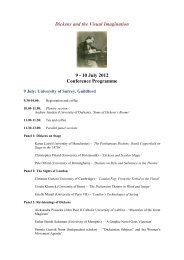The targeted killing of terrorists on foreign soil - Institute of Advanced ...
The targeted killing of terrorists on foreign soil - Institute of Advanced ...
The targeted killing of terrorists on foreign soil - Institute of Advanced ...
You also want an ePaper? Increase the reach of your titles
YUMPU automatically turns print PDFs into web optimized ePapers that Google loves.
Tobias Ruettersh<str<strong>on</strong>g>of</str<strong>on</strong>g>f<br />
Panel 4 (a)<br />
structure in combinati<strong>on</strong> with sophisticated tactics and necessary logistics shows that it is<br />
necessary to counter <str<strong>on</strong>g>terrorists</str<strong>on</strong>g> with c<strong>on</strong>tinued and coordinated military measures (see<br />
Schmitz-Elvenich 2007, 196). Even though the subsumpti<strong>on</strong> <str<strong>on</strong>g>of</str<strong>on</strong>g> c<strong>on</strong>flicts between a state and<br />
an internati<strong>on</strong>al terrorist organisati<strong>on</strong> under Comm<strong>on</strong> Article 3 GC may appear as a<br />
“loophole” (Bruha 2002, 419), it withstands a judicial review as l<strong>on</strong>g as the requirements <str<strong>on</strong>g>of</str<strong>on</strong>g><br />
durati<strong>on</strong>, intensity and organisati<strong>on</strong> are fulfilled. It can thus be c<strong>on</strong>cluded that those c<strong>on</strong>flicts<br />
can be c<strong>on</strong>sidered as n<strong>on</strong>-internati<strong>on</strong>al armed c<strong>on</strong>flicts which allow the applicability <str<strong>on</strong>g>of</str<strong>on</strong>g> IHL.<br />
3.3.3 Legal c<strong>on</strong>sequences<br />
Since IHL is applicable, the questi<strong>on</strong> arises what legal c<strong>on</strong>sequences follow for the <str<strong>on</strong>g>targeted</str<strong>on</strong>g><br />
<str<strong>on</strong>g>killing</str<strong>on</strong>g> <str<strong>on</strong>g>of</str<strong>on</strong>g> <str<strong>on</strong>g>terrorists</str<strong>on</strong>g>. It needs to be determined whether <str<strong>on</strong>g>terrorists</str<strong>on</strong>g> can become legitimate<br />
targets <str<strong>on</strong>g>of</str<strong>on</strong>g> military measures and which caveats exits with regard to the protecti<strong>on</strong> <str<strong>on</strong>g>of</str<strong>on</strong>g> the<br />
populati<strong>on</strong> and general proporti<strong>on</strong>ality <str<strong>on</strong>g>of</str<strong>on</strong>g> the attacks.<br />
One <str<strong>on</strong>g>of</str<strong>on</strong>g> the basic rules <str<strong>on</strong>g>of</str<strong>on</strong>g> IHL is the principle <str<strong>on</strong>g>of</str<strong>on</strong>g> distincti<strong>on</strong>. It clarifies that in an armed<br />
c<strong>on</strong>flict <strong>on</strong>ly two categories <str<strong>on</strong>g>of</str<strong>on</strong>g> pers<strong>on</strong>s exist: civilians or combatants (see Dörmann 2003,<br />
72). Under internati<strong>on</strong>al law, civilians must not be intenti<strong>on</strong>ally <str<strong>on</strong>g>targeted</str<strong>on</strong>g>. Only legal<br />
combatants or pers<strong>on</strong>s participating directly in the hostilities <str<strong>on</strong>g>of</str<strong>on</strong>g> an armed c<strong>on</strong>flict may be<br />
<str<strong>on</strong>g>targeted</str<strong>on</strong>g> (see O’C<strong>on</strong>nell 2010, 21). But the classificati<strong>on</strong> <str<strong>on</strong>g>of</str<strong>on</strong>g> <str<strong>on</strong>g>terrorists</str<strong>on</strong>g> under this scheme is<br />
difficult, as they do not have such a status under internati<strong>on</strong>al law (see Frowein 2002, 893).<br />
<str<strong>on</strong>g>The</str<strong>on</strong>g>y are – as shown – not legal combatants and would then have to be classified as civilians,<br />
following the basic idea <str<strong>on</strong>g>of</str<strong>on</strong>g> internati<strong>on</strong>al law. C<strong>on</strong>sequently, the questi<strong>on</strong> arises when and<br />
how terrorist can become the target <str<strong>on</strong>g>of</str<strong>on</strong>g> attacks, including <str<strong>on</strong>g>targeted</str<strong>on</strong>g> <str<strong>on</strong>g>killing</str<strong>on</strong>g> operati<strong>on</strong>s, despite<br />
their missing combatant status. A possible soluti<strong>on</strong> could be the status <str<strong>on</strong>g>of</str<strong>on</strong>g> ‘illegal combatant’.<br />
<str<strong>on</strong>g>The</str<strong>on</strong>g> protecti<strong>on</strong> <str<strong>on</strong>g>of</str<strong>on</strong>g> civilians under IHL is not absolute. As Article 51 (3) AP I states:<br />
“Civilians shall enjoy the protecti<strong>on</strong> afforded by this secti<strong>on</strong>, unless and for such time as they<br />
take a direct part in hostilities” (ICRC 1977b). Such civilians which directly participate in<br />
hostilities are predominantly c<strong>on</strong>sidered as ‘illegal’ or ‘unprivileged’ combatants (see e.g.<br />
Dinstein 2004, 29; Watkin 2003, 4). <str<strong>on</strong>g>The</str<strong>on</strong>g> classificati<strong>on</strong> <str<strong>on</strong>g>of</str<strong>on</strong>g> illegal combatant is thus not based<br />
<strong>on</strong> a status (as it is with civilians and combatants) but <strong>on</strong> a certain behaviour. It is reas<strong>on</strong>ed<br />
in the ‘in<str<strong>on</strong>g>of</str<strong>on</strong>g>fensive’ character <str<strong>on</strong>g>of</str<strong>on</strong>g> civilians. <str<strong>on</strong>g>The</str<strong>on</strong>g>ir passivity is a rigorous and logical<br />
prerequisite for their special protecti<strong>on</strong> (see Sandoz 1987, para. 1944). If a civilian<br />
participates in hostilities, he gives up his passivity and does not have the characteristic<br />
feature <str<strong>on</strong>g>of</str<strong>on</strong>g> a civilian anymore. At least for the time <str<strong>on</strong>g>of</str<strong>on</strong>g> his participati<strong>on</strong> in hostilities, he<br />
forfeits his protecti<strong>on</strong> (see Dinstein 2004, 29), but not generally (see Dörmann 2003, 72).<br />
- 20 -
















